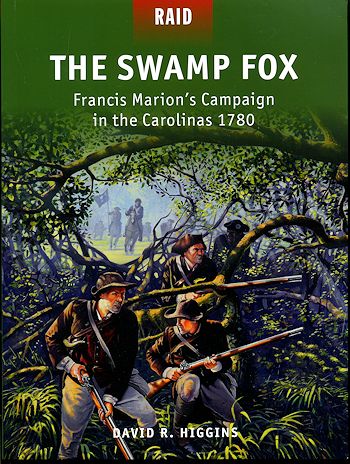 This latest
book in Osprey's Raid series seems to be a bit off the beaten track for a book
in this series. Rather than concentrate on a singular event, as have the others
I've read, this one is more like a title from the Campaign series. Perhaps there
was not enough to make into one of those larger editions and so it was placed in
with this series.
This latest
book in Osprey's Raid series seems to be a bit off the beaten track for a book
in this series. Rather than concentrate on a singular event, as have the others
I've read, this one is more like a title from the Campaign series. Perhaps there
was not enough to make into one of those larger editions and so it was placed in
with this series.
Regardless, it is a well done book that covers the
campaigns in South Carolina during the 1780s in general and the forays of
Francis Marion in particular. Before going any farther, Marion was never called
'the swamp fox' during his life. This was drummed up later after he died by
biographers and those wishing to embellish his life. In truth, Marion was not
what one would call a dashing figure. He was, however, quite intelligent and
knew how to make the best of what he had.
He realized early on that his band of South Carolina
militia would never be able to stand up to a 'normal' battle such as the British
wanted. He knew that his men would come and go as they pleased, a situation
typical of militia. These men did not sign up for a period of time, but only for
as long as they felt they would be useful and able to hit the British. When
planting or harvest season came along, these men would leave and go back to
their families. Young men they were not, the most of them having a wife and
children. This was quite unlike the Continental Army where most soldiers were
young, unmarried men.
The militia was also never a very strong force, rarely
being able to field more than a few hundred men for any operation. With all this
in mind, Marion knew that he had to fight a battle that constantly kept the
British on the defensive. One that would attack their logistics, and their more
scattered outposts. There was also a huge distrust of the Continental Army, and
while there was some cooperation, for the most part, the militia wanted to
remain separate and under their own command.
With this as a background, Marion and his troops did the
best they could with what they had. They were able to inflict considerable
damage on the British and forced them to whittle away their strength in keeping
open lines of communication. The British (mostly under Corwallis), also
underestimated the amount of loyalist support they would get in this area. While
there were loyalist troops, it would be not infrequent for these troops to swap
sides when they saw their own cause at a disadvantage. Of course, the British
were quite harsh with these men when they were caught and equally harsh with
those who they thought were supporting the rebellion.
Marion also had the benefit of his militia being skilled
at arms, familiar with the surroundings and able to live outdoors for long
periods of time with minimal supplies, unlike the more regimented British. It
was Marion's use of unconventional warfare that was the key to his success in
most of the skirmishes in which he was involved. In the lone 'big battle' at
Cowpens, Marion was able to triumph against a superior force that should have
won the day.
The author covers the early life of Marion as well as
the events of the war that let to his rise in prominence. All of the various
battles in which he was involved during this time are covered along with some
fine photos of the places they happened as they are today. Superb illustrations,
both modern and period, help to illustrate this most interesting volume where
politics often played as big a part as the battles themselves. A fine read that
I know you will enjoy reading.
December 2103
For more on the complete line of Osprey books,
visit www.ospreypublishing.com. In the US, it is
Osprey Direct at 44-02 23rd St, Suite 219, Long Island City, NY 11101., where you can
get a catalogue of available books.
If you would like your product reviewed fairly and quickly, please
contact
me or see other details in the Note to
Contributors.
 This latest
book in Osprey's Raid series seems to be a bit off the beaten track for a book
in this series. Rather than concentrate on a singular event, as have the others
I've read, this one is more like a title from the Campaign series. Perhaps there
was not enough to make into one of those larger editions and so it was placed in
with this series.
This latest
book in Osprey's Raid series seems to be a bit off the beaten track for a book
in this series. Rather than concentrate on a singular event, as have the others
I've read, this one is more like a title from the Campaign series. Perhaps there
was not enough to make into one of those larger editions and so it was placed in
with this series.